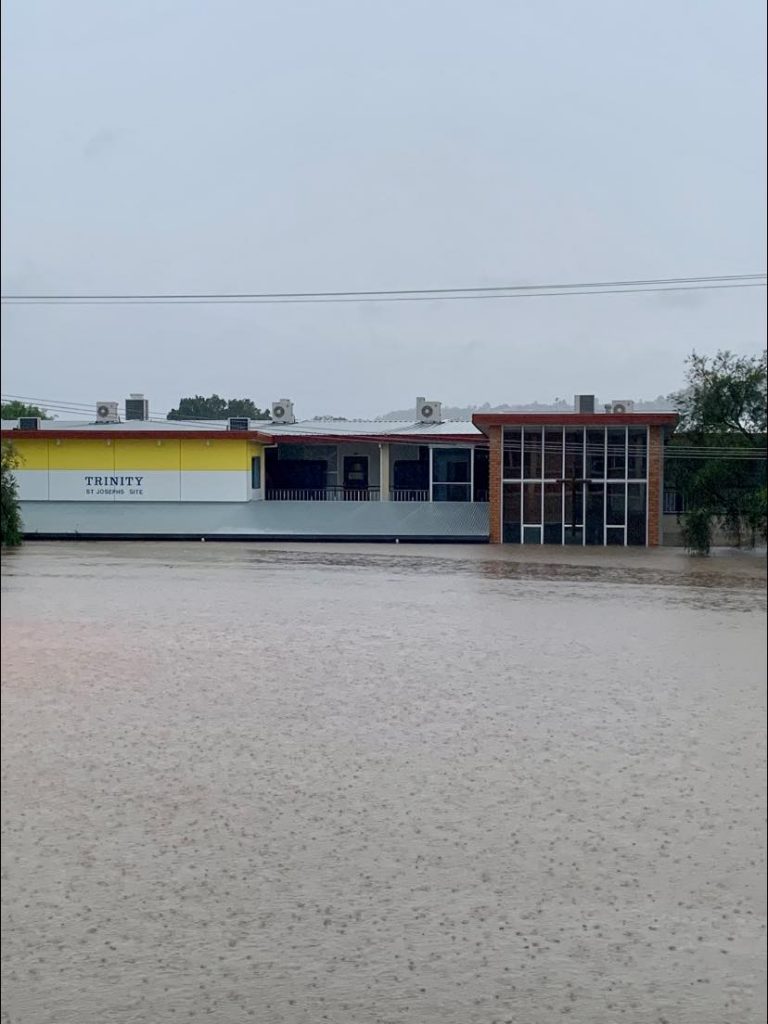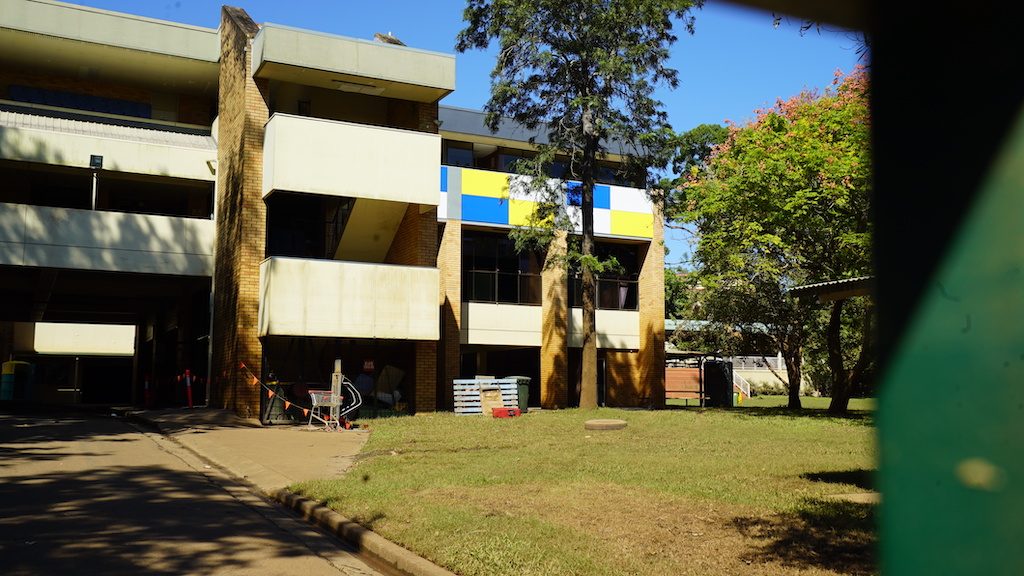“Everyone Is Trembling On The Inside”: How Schools Are Cleaning Up After The Lismore Floods
"There are students of ours that don't like getting in a bath or having a shower simply because water traumatises them."

On the morning of Monday, February 28, Trinity Catholic College Lismore’s principal Jesse Smith drove down the hill from his house in Lismore Heights.
He navigated his way to St Carthages, the primary school that sits on Dawson Street, between the St Joseph’s junior site and senior St Mary’s site of Trinity. That morning, in the dark early hours, the Lismore town levee had been breached by wild floodwaters, which reached 14.4 metres — more than two metres above the previous town records.
Smith had seen floods in Lismore many, many times before. Trinity — my former high school — flooded on numerous occasions throughout my school years and Smith, a former student himself, had seen it all before. But this time was different.
He stared across at the junior site and noticed the water was already lapping at the first floor.
“That’s when I knew this was going to be catastrophic,” Smith tells me, sitting in Trinity’s makeshift school ground at Southern Cross University. “If it was already lapping at the first floor… and it had some distance still to go. I just thought this is going to be enormous.
“The updates just kept coming and the water just kept coming. So, a metre through the top level of St Joseph’s site… it reached the second level of St. Mary’s site. Never, ever has water been in that second level.”
Over the two sites, Trinity has around 103 classrooms. Only eight of them weren’t inundated with floodwaters.

Floodwaters reached the first floor of Trinity on the morning of the 28th. They would go higher. Credit: Trinity Lismore Facebook
The Aftermath
The damage across the two sites was — as Smith politely and stiffly puts it — significant. They still don’t know the state of the damage, and Smith says it will take months before they know the true extent of it. The Australian Defence Force came through and cleaned out the campuses, chucking out huge piles of computers and desks and chairs and everything else inside — but this was hampered by a second flood that tore through the town just over a week ago.
Standing outside the St Mary’s site, the impact of the flood is clear and — even when it’s right in front you — almost unbelievable. Mud coats the buildings, piles of rubbish lie in the courtyards. We crane our necks to try and see the water line — metres and metres and metres above our heads. I spy one of my old classrooms, windows broken, electrical wires hanging.
Trinity wasn’t the only school affected, of course. There is barely a thing in Lismore the flood waters didn’t touch. The Richmond River campus of the Rivers Secondary College — which comprises the former schools of Kadina, Lismore High, and Richmond River — was almost razed to the ground. We crawl past it in South Lismore, windows blown out, trees leaning against buildings, like a bomb has ripped through. There’s a lot of speculation in the community about whether the campus will ever open again.

Floodwaters surrounding Trinity Lismore. Photo: Trinity Lismore Facebook
Schools across the Northern Rivers have scrambled to reopen. After two years of COVID, online learning can be quickly arranged, but it’s not perfect — and many students have been personally affected by the floods, their own homes and belongings destroyed.
Some Year 12 students from Rivers Secondary told the local ABC radio they had their major works for art and textiles, which they’d worked on for months, obliterated in the event. Instruments were lost from music rooms, science equipment vanished, every computer broken — every part of what makes a school just taken away.
The Fallout
Southern Cross University, tucked behind a hill in Goonellabah, an eastern suburb of Lismore, has become home to a number of organisations and businesses after the floods. Trinity is now tucked into a corner of the campus, with a few classes of students here for on-campus learning — most other students are online.
We meet Smith on a scorching hot Lismore day at recess time, the students milling about and happily eating. It’s a warming scene, but it belies the reality of what everyone has been through. Smith is polite and kind, but there’s a shake in his voice that’s hard to ignore.
“We are dealing with a trauma-affected community,” he says. “And that will be the case for many months and years, even though the political spotlight, the media spotlight, the national spotlight will be gone the moment the federal election is called. We’ll still be in recovery mode dealing with traumatised people.
“There are students of ours that don’t like getting in a bath or having a shower simply because water traumatises them.”
“There are students of ours that don’t like getting in a bath or having a shower simply because water traumatises them. When you multiply that by having that second flood event last week, and the fact that we had this enormous storm that sat over us for 12 hours, that’s just hard for people. So, for me, the buildings aren’t important right now.”
He has praise for all levels of government, which he says have been helpful with getting Trinity back on its feet — but he doesn’t say the same about the bureaucracy of some officials in the education system. “I’m getting phone calls saying ‘why haven’t you signed up for NAPLAN?” he laughs. “[They] just don’t understand at all.”
“Schools are just expected to continue, but those making decisions about these things are not on the ground. And they don’t actually have that human connection with year seven students who are traumatised or year nine students who may have been plucked off their roofs by helicopters or boats. That’s what you’re dealing with.”
There are a lot of brave faces, he says, but everyone is trembling on the inside.

The empty St Mary’s site after the floods. Photo: Junkee
The Path Forward
It’s unclear when Trinity, or other schools around the region, will be able to return to their own campuses. Some schools — like Rivers Secondary College — can squeeze into different campuses that weren’t affected by the flood, with some added demountables for the extra students. Some, like schools downstream that were decimated in Woodburn, Broadwater, and Wardell, are facing massive demolition and rebuilding work. This week, the NSW Government announced a $67 million package to assist.
For now, it’s a juggling act from day to day — to support the students through their work, maintain some semblance of normality, and support them psychologically. As Smith says, it’s the psychological clean up that will be the toughest.
The second flood, a Trinity year 12 student Perrin tells us, really affected people. “People were like ‘this is just my life now, just cleaning up’,” she says. Flowers and assistance from people in towns like Byron Bay and Lennox Head helped, she says, but there’s no doubt the school kids are incredibly stressed, despite what it might look like on the outside. Being among friends — particularly after the two years of COVID — is important for the students right now.
Smith notes that the second flood dealt numerous frustrating blows to a community just trying to keep it together. One thing, he says, was that piles of belongings that were collected on the pavement after the first flood were simply carried away by the second, adding to the mammoth clean-up.
“Some people mistakenly say, ‘well that stuff on the side of the street is rubbish’. It’s not rubbish: that’s people’s lives and memories and possessions,” says Smith. “They’re things that connect them to holidays and family members and all sorts of stuff, really prized possessions. They’re literally sitting in a heap and they floated away, it was horrendous.”
When I ask what people in the cities need to understand about this event, he pauses for a moment.
“I want them to understand that long after the floodwaters have receded people’s lives are still affected,” he tells me. “That’s what they need to understand — this is not a matter of days or weeks. It’s a matter of months and years. Don’t forget about it. Check-in and see how little old Lismore’s going. It’s not so much about the buildings — it’s about the people. Because that’s what you’re trying to rebuild. Don’t forget about us.”
Jules LeFevre is the editor of Junkee. Follow her on Twitter.
Photo Credit: Dan Peled/Getty

